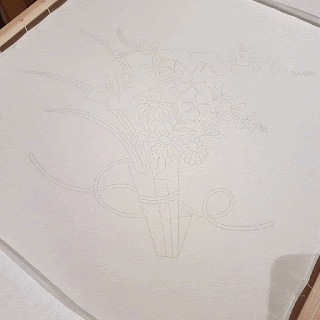Hope everyone had a lovely Easter weekend! I had a very productive long weekend. I took out Hiogi and worked on completing a few of the elements we had started in class.
The first element is the woven effect. Towards the end I noticed there was something wrong but it's not very noticeable from afar. I think I might have made a mistake in the third step when we had to tie down the gold thread. Something to improve on for next time.
The second element I finished is the tie dye effect. Once I got going, I did this by eye. I'm surprised at how nice this came out. I've seen this technique done in books with different color combinations and they look lovely. Now I can say I can stitch it.
The last element I completed is the sayagata cloud, which was very near the end. It was only missing some of the lightning. After that it was a matter of removing my temporary holding stitches and couching everything down.
All of them need to be outlined, but that's being done in the next class I think. Still that's three elements to strike off my to-do list:
I'm going to try and work on some of my other projects for a bit though. Otherwise, I will have nothing to work on during my monthly Japanese embroidery meetings.
Last week I received a comment from someone who was a noreply-comment. Nicole M. asked: i noticed on your fabric the leaves have the veins drawn in. But when you are doing your stitches, they don't seem to be used for anything. It that right? Is there a reason that those type of details are on your ground fabric when you don't seem to be using them for anything?
Here is an answer but don't take my word for it as I'm still learning. Often in Japanese embroidery designs are created by cutting up pieces and putting them together in a way that is pleasing for them. I have a few design books at home that have multiple pages of how chrysanthemums are drawn for example. You pick the shape you like (rounded or pointed petals), drawn from the side or on top,.. and combine it together with other elements to create a whole new design to stitch. The leaves you see in my piece are called paulownia leaves and that's how they draw them in Japan. You can stitch these in green to look like the leaf and put in veins (one of them will be), but it just so happens that they decided to embroider the others using different effects.
The first element is the woven effect. Towards the end I noticed there was something wrong but it's not very noticeable from afar. I think I might have made a mistake in the third step when we had to tie down the gold thread. Something to improve on for next time.
The second element I finished is the tie dye effect. Once I got going, I did this by eye. I'm surprised at how nice this came out. I've seen this technique done in books with different color combinations and they look lovely. Now I can say I can stitch it.
The last element I completed is the sayagata cloud, which was very near the end. It was only missing some of the lightning. After that it was a matter of removing my temporary holding stitches and couching everything down.
All of them need to be outlined, but that's being done in the next class I think. Still that's three elements to strike off my to-do list:
finish sayagata cloud- finish shippo cloud
- finish the snow flake in the upper right corner
finish the woven effect paulowniafinish the tie dye effect paulownia- start and finish the flax leaf effect paulownia
- start and finish the separated single layer paulownia (low priority)
I'm going to try and work on some of my other projects for a bit though. Otherwise, I will have nothing to work on during my monthly Japanese embroidery meetings.
Last week I received a comment from someone who was a noreply-comment. Nicole M. asked: i noticed on your fabric the leaves have the veins drawn in. But when you are doing your stitches, they don't seem to be used for anything. It that right? Is there a reason that those type of details are on your ground fabric when you don't seem to be using them for anything?
Here is an answer but don't take my word for it as I'm still learning. Often in Japanese embroidery designs are created by cutting up pieces and putting them together in a way that is pleasing for them. I have a few design books at home that have multiple pages of how chrysanthemums are drawn for example. You pick the shape you like (rounded or pointed petals), drawn from the side or on top,.. and combine it together with other elements to create a whole new design to stitch. The leaves you see in my piece are called paulownia leaves and that's how they draw them in Japan. You can stitch these in green to look like the leaf and put in veins (one of them will be), but it just so happens that they decided to embroider the others using different effects.










































